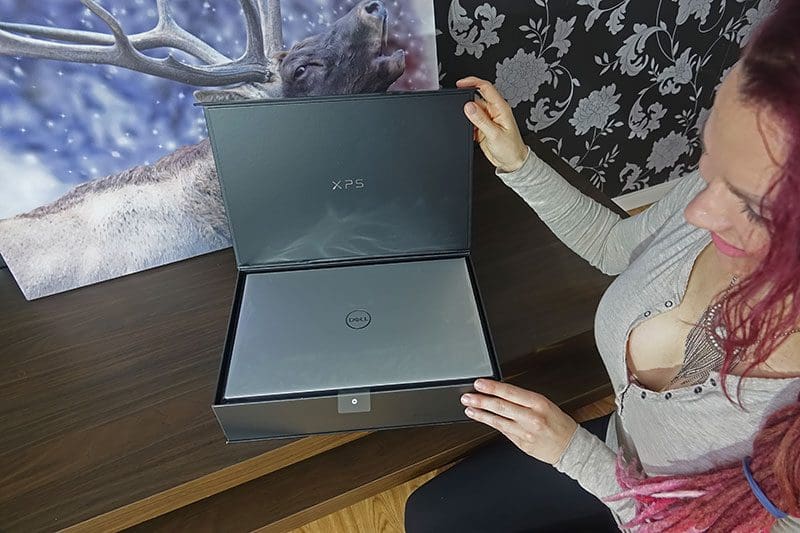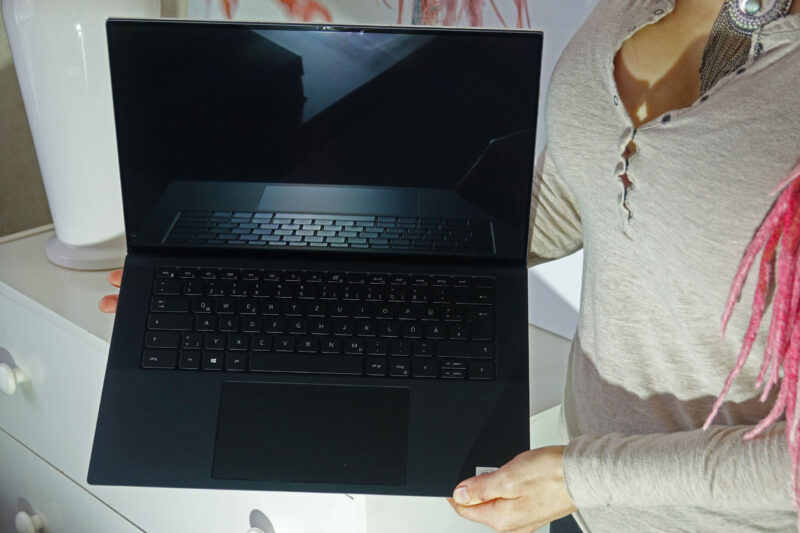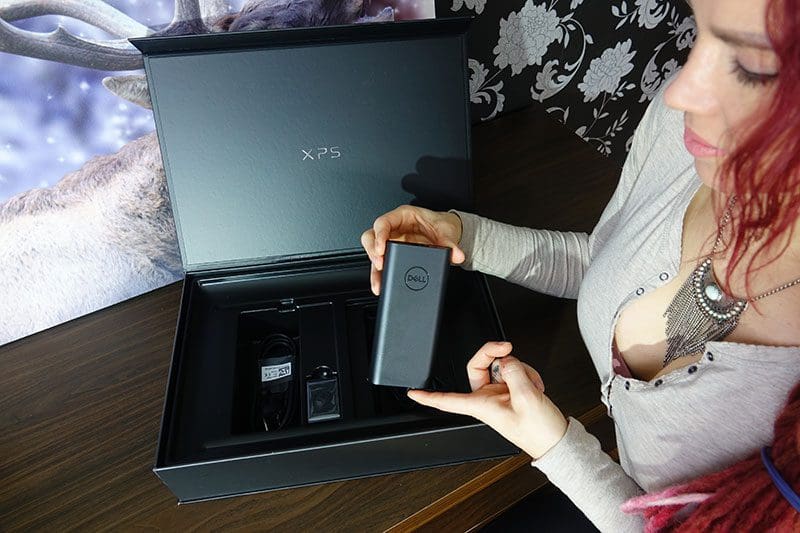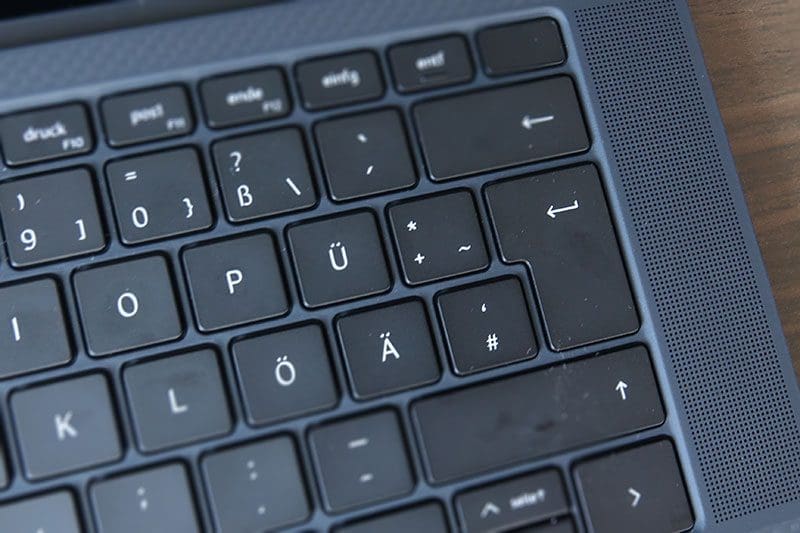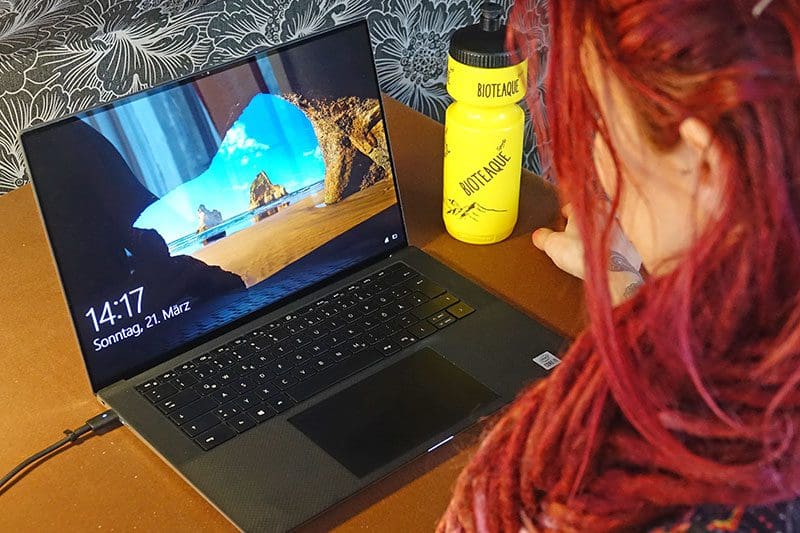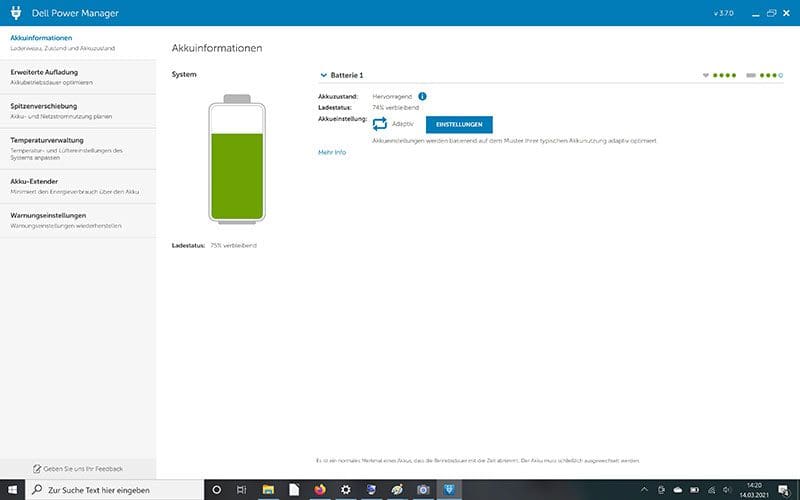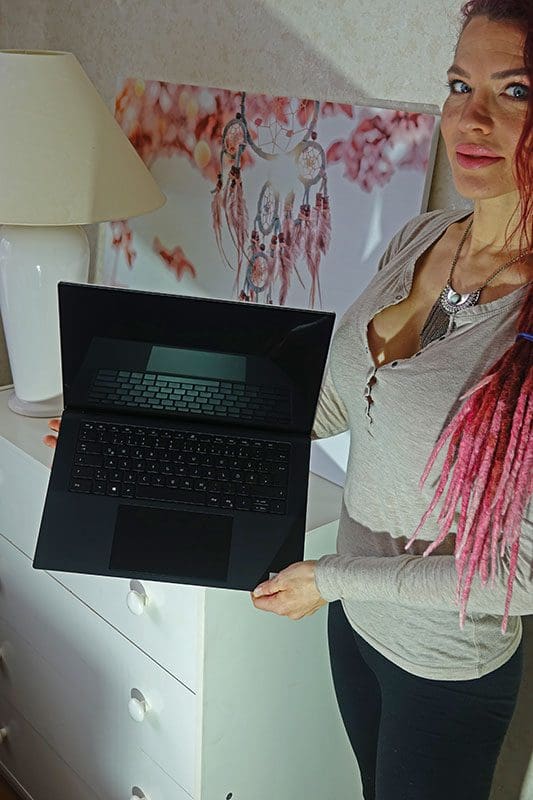15" Laptop Dell XPS 15 9500 (2020) Review


In spring 2019, we already introduced the Dell XPS 13, which has since accompanied us on our journey through Europe. As a small, light and compact laptop, it was ideal for this. However, to coincide with the start of our "Survival of the Market Winter" project, we have now received the new Dell XPS 15 to test it as well. The slightly larger and therefore heavier version might not have been the first choice for a backpacking trip, but it has decisive advantages when you stay in one place for a longer time. Therefore, this device is again particularly interesting for web nomads and all those who need a real work machine with performance, power, versatility and reliability. Now that we have been able to test the XPS 15 extensively over the past few weeks, it is time for our first experience report.

We already reported about its little brother, the XPS 13, in 2019. Click here to go directly to the test report of the Dell XPS 13.
Who is the Dell XPS 15 suitable for
Dell's XPS 15 is definitely a laptop for people who need full power for their work on the go. It's an extremely powerful premium device with optimal resolution and colour depth, so it's great for film editing, image processing and design work. At the same time, it is still compact and light enough to be easily portable, so you can use it comfortably when travelling, in your own caravan or expedition vehicle, in cafés, libraries and hotels, but also outdoors. If you value fast, precise work with a lot of storage capacity, high robustness and durability and at the same time extreme precision, the Dell XPS 15 is a good choice. More about this in the detailed report.
The first impression
The packaging
The Dell XPS 15 comes in a very elegant matt black box, which is only decorated with a grey Dell logo, consists of a haptically very appealing, solid cardboard and can be opened with a magnetic closure. Although this is only the packaging, Dell already shows that they have placed value on high quality here.
The basic design
When opening the packaging, it immediately became clear that Dell has also given its new 2020 generation of the XPS series a new design. What has remained unchanged is the high-quality workmanship and the complete absence of unpleasant corners and edges, which makes working with the XPS series laptops so pleasant.
Material and processing
The material has also remained unchanged. The case of the XPS 15 is again made of high-quality milled aluminium with diamond-cut side panels. The top is made of robust carbon when opened. This is available from Dell in two colours, once in white and once in black. Once again, we opted for the black version, which in my opinion looks a little more elegant, although fingerprints are more visible. But it should be obvious that a work device like the XPS 15 is not completely without signs of use. On the other hand, the carbon fibre is very pleasant on the hands and does not feel unpleasantly cold as quickly in colder ambient temperatures, as is the case with MacBooks, for example. Incidentally, the carbon is exactly the same material that is also used in car racing to make the car bodies particularly light and extremely robust and resilient at the same time. Dell has really not let itself down here and offers its customers an absolutely high-quality product for their money, which can also withstand minor falls or knocks without any problems.
The screen is made of sturdy Gorilla glass from Corning and is therefore largely shatter- and scratch-proof. To be on the safe side, we did not test how much it can really withstand. The new basic design of the laptop also means that the XPS 15 9500 is much easier and more comfortable to open. However, the hinge does not lose any of its stability and always remains in the exact position you set the screen to, even when typing on wobbly surfaces such as your own legs.Size and weight
With its 2 kg weight, it is significantly heavier than our MacBook Air and also than its little brother, the SPX 13, but for a 15" laptop it is still lighter than expected. Thanks to the "Infinity Edge" technology of the screen, where almost the entire space of the laptop top is filled with the monitor and there are almost no edges, it is, like the SPX 13, a good deal smaller than most competitors from the same size category. Therefore, the XPS 15 is still suitable as a travel laptop. Especially when you consider how incredibly heavy some of the small tablets are and how heavy laptops were just a few years ago.
The charger
Right from the first glance, the charger triggered somewhat mixed feelings in us. On the one hand, we were again very pleased with the generously sized charging cable, which allows you to be relatively flexible even when connected to the mains. The effect is further enhanced because the XPS 15 again has a USB-C port on both sides for charging, so you don't have to awkwardly wrap the cable around you as you used to.
However, we were less convinced by the size and weight of the charger. Visually, it resembled the charger of the 13" model from 2018, but it was more than twice as big and correspondingly heavier. Especially for a laptop, where otherwise a lot of emphasis was placed on compactness and lightness, I would have liked a slightly more compact charger. On the other hand, of course, with 130 w to 45 w, it also provides significantly more power, which probably justifies the size. As a frequent traveller, however, I have to say that I personally would have gladly accepted a slightly longer charging time for a smaller charger.
The connections
On the left side of the laptop are two USB-C ports, each of which also has Thunderbolt™ 3. Next to them is a small opening for attaching a security lock, which is also not wrong for a travel laptop.
On the opposite side, there is no mini SD card reader this time compared to the XPS 13, but a reader for normal SD cards. I find this quite positive, as most cameras still run with SD cards and mini SD cards can still be read without any problems with a simple and ultra-light adapter. On the other hand, to read normal SD cards, you always had to connect a card reader via USB, which in turn required a USB-C to USB-A adapter. The whole thing was therefore somewhat complicated and led to a significant slowdown in reading speed when working with SD cards. In contrast, this change is now a clear advantage.
However, it also has a small disadvantage, because unlike the mini-SD card port of its little brother, the SD card reader of the XPS 15 does not have a spring mechanism and only accepts the cards up to about halfway. So they don't disappear but stick out, which means you can no longer use them as a permanent hard drive expansion. In addition, you have to be careful when transporting the card to remove it beforehand to avoid possible damage.
Also on the right side is another USB port and a jack for headphones and headsets. The USB port here does not have integrated Thunderbolt™ 3, but it does have a display port, so you can still connect a monitor here. As already mentioned, the charging cable can also be connected here. This means that the Dell XPS 15 can also be connected to a large desktop screen with a corresponding cable if required, so that you can work on it even more effectively. An additional graphics card can also be connected in the same way.
Unfortunately, there is no USB-A port on the XPS 15 either, which I find very regrettable, as I did with the XPS 13. Once again, Dell is cutting its own hand in terms of compactness and suitability for travel, because on the one hand you save a little weight, but on the other you always have to take an adapter with you, which adds weight and can easily get lost. Fortunately, such an adapter is also included in the package this time. However, it is considerably larger than on the XPS 13 and has an HDMI 2.0 port in addition to a USB-A port. That's practical, but if you're forced to have such an additional box, a few more ports might have been nice as well. Especially since there would have been room. For example, for a mini SD card slot.
The keyboard
The first thing you notice when typing is the pleasantly soft and, above all, quiet stroke, which is slightly longer than on the current MacBooks. This is particularly pleasant when typing longer texts, as you can write very sensitively and at the same time very precisely. With the 2020 generation, Dell has also fixed a significant shortcoming that I always noticed negatively with the XPS 13 from 2018 and that I could never really get used to. This was that the arrow keys were split altogether and thus only half the size of the other keys. This was no problem with "Up" and "Down", but the left and right keys shared space with the "Page up" and "Page down" keys. Here it happened all too quickly that if you did not type 100 % accurately, the cursor did not jump one letter to the left or right, but a whole page down or up, which could seriously interrupt your writing flow.
On the current XPS 15, the up and down keys are still split, but the left and right keys again take up a full key width and thus cannot lead to confusion. The "Page up" and "Page down" functions have not disappeared because of this, but are still available via the arrow keys in combination with the Fn key, which is a much better solution in my opinion.

The left and right arrow keys no longer have a confusing dichotomy compared to previous generations of the XPS 15.
Dell has also refrained from unnecessary experiments with the keyboard, which are usually introduced on laptops in order to save space. I remember, for example, a single-line Enter key that regularly drove me crazy on one of my earlier devices. There is no such thing here, at least not on the German version of the keyboard, and that is a very good thing. So I can say with a clear conscience that I am completely satisfied with this version of the keyboard.
Like my XPS 13, the keyboard of the Dell XPS 15 9500 can be illuminated from the inside when needed. Unlike MacBooks, the brightness cannot be adjusted since there are only the options "on" or "off", but this is not necessary in my opinion. I really like the automatic feature, i.e. the fact that the keyboard automatically lights up when it gets darker in the room and turns off again when the lighting conditions improve. Therefore, I have rarely had to use the manual setting.
On the other hand, there are significant changes in the top row of the keyboard, i.e. the function keys. Here you will now find some functions, such as brightening and darkening the screen, which were previously distributed across the keyboard. Other functions are completely missing, which in my eyes is not a big deal, since in most cases they were actually functions that I, at least, rarely or never used. To be honest, I only found out about the functions of some keys by comparing the keyboards of the XPS 13 and the XPS 15.

The top keyboard row on the 2018 version of the XPS 13 compared to that of the current XPS 15 model.
The touchpad
The touchpad is probably the most noticeable change compared to the previous models. It is now much larger and has also improved significantly in terms of handling. As with the MacBook and previous XPS generations, there are no buttons. Instead, the touchpad can be pressed down slightly as a whole, which also leads to a "click" when tapped briefly. Unfortunately, the "clicking noise" caused by pressing down the touchpad is relatively loud. Not so loud that it disturbs you directly, but more audible than it should be. This is the only small drawback. Otherwise, thanks to the new and improved Windows Precession driver software, the use of the touchpad works much better than with the predecessors and thus comes close to an Apple touchpad. Unfortunately, still not quite, but it is still by far the best touchpad I have ever used on a Windows computer. The usual hand gestures, such as zooming and scrolling, work particularly well. Dell has clearly surpassed itself with this version.Loudspeaker and sound experience
Another very noticeable innovation in the 2020 generation of the XPS series are the speaker openings, which are now located to the left and right of the keyboard. Compared to previous versions and other Windows laptops, they provide a significantly improved sound experience. The overall sound is now much fuller and clearer, far better than anything you are normally used to from Windows computers. Unfortunately (and this is a pretty big "unfortunately"), Dell still doesn't come close to the sound volume of a MacBook with this. You can't say exactly what it is that's missing here, but something is missing and this results in an overall sound that is comparable to that of a kitchen radio. As I said, it's so good that you can really enjoy listening to music or watching films, but it's still not brilliant. In this respect, there is still some potential for Dell to improve this in future models.
The webcam
As an XPS 13 user, I immediately noticed that the webcam on the new XPS 15 is now on the top of the screen again and not on the bottom as before. This was a peculiarity of the XPS 13 that I could not quite get used to until today. When you make conference calls with video transmission, you are filmed from a frog's-eye view due to the low camera position and when you want to write something in between, your hands are huge and right in the front of the picture. The position above the screen is much better. As with the predecessors, the webcam also has Windows Hello support. This means that if you have set up the computer accordingly, you can log in automatically via facial recognition when you open the laptop and then no longer need a pin. Unfortunately, we can't tell you how well this actually works because we deliberately decided not to use Windows Hello. Incidentally, we were quite impressed by the quality of the webcam. It is certainly not the best on the market and there is also some potential for improvement here, but you should not forget that it is in a tiny and wafer-thin frame and therefore has to be extremely small itself. In return, however, it delivers very usable results and still takes quite good pictures even in low light conditions.
The webcam is again located on the upper side of the screen in the new generation of Dell XPS 15 computers.
The screen
A clear change in the screen is also immediately noticeable. It no longer has a 16:9 format like the 2018 XPS 13, but a 16:10 format and thus offers a little more space at the top and bottom for working. Which aspect ratio is optimal for a screen is of course a matter of taste, but I personally like the new variant much better. With the 16:9 ratio, I often had the problem that websites in particular were displayed very large and you could therefore only see a little at a glance upwards and downwards if you didn't zoom out. I no longer see this problem with the 2020 XPS 15. As with the previous generations, you can again choose between two different screens on the 2020 version:- The Full HD variant without touch function in glossy, but with anti-reflective coating.
- The 4K variant with touch function in matte.
The operating volume
Another significant improvement compared to our predecessor model was noticed in the fan. As long as you perform simple tasks, such as writing texts, surfing the Internet or even lighter image editing or programming work, the 2020ger XPS 15 is completely silent. Only when it is really challenged does the fan start to run, and this time there is not just on and off, but a range of different power levels. If there is a slight warming due to the work being carried out with the device, the fan starts up slowly at first, so that it cools but is still barely audible. If the computer gets more stressed, the fan naturally speeds up and gets louder, but even in the maximum setting, it can be said that Dell has placed emphasis on quality and built in a particularly quiet fan. Another positive aspect is that the fan does not immediately run at full speed during heavy use, but first causes a cooling boost and then slows down again or switches off completely until it is needed again. Of course, a high-performance device like the XPS 15 automatically produces a lot of heat and therefore needs to be cooled. There's no getting around that. But Dell has done everything to ensure that the cooling process remains in the imperceptible to barely perceptible range for as long as possible and is still bearable even under maximum load. Only the rather high frequency is somewhat annoying, as the sound of the fan itself is unfortunately not too pleasant. At least, however, there is usually no feeling that the laptop is about to take off if the fan accelerates even further.
Battery and power supply
A 6-cell battery with 86 Wh is installed in the XPS 15 9500. The latest generation is even more compact than the predecessor model, although there is again the problem that the battery life depends very much on the modification of the laptop and can sometimes be shockingly short. In general, it is a good deal longer with the Full HD screen than in the 4K variant. However, Dell has taken into account that the 4K display is a real energy guzzler this time and therefore automatically installs a somewhat larger battery if you opt for this variant. Therefore, the overall effect is not quite as great as with the predecessor models. With our model, which is equipped with a 4K screen, we get a good 8 hours of battery life for simple tasks, such as writing texts or surfing the Internet, if you lower the screen's brightness a little. However, since it is very bright anyway, as described, this is usually not a problem. However, if you work with Photoshop or film editing programmes and turn up the screen brightness a little more to really see everything clearly, you can almost watch the battery level indicator drop. In extreme cases, we sometimes didn't even get two hours. So we can clearly say that the 4K version of the XPS 15 9500 certainly works as a travel and mains independent laptop when you do simple work. But if you want to use all its power, you should also plug it into the mains. We were not able to test the Full HD version ourselves, but from what we have been able to research on the internet so far, the battery lasts about 25 % longer for all activities. The maximum battery life should be around 12-13 hours. We know from our 2018 XPS 13 that the battery life unfortunately decreased more and more after about a year and now barely lasts more than one to two hours after two years, even with light tasks. Of course, this does not allow us to draw any reliable conclusions about the battery installed in the 2020 XPS 15, but there is still some concern that it could be similar. Of course, we will only be able to say more about this over time, and we hope that the battery's longevity has also improved significantly. As an alternative to the original charger, the Dell XPS 15 from 2020 can also be charged with all other USB-C chargers, as long as they have Power Dellivery support. Unfortunately, this only works poorly or not at all when the computer is in operation. If you don't have the original charger with you, it makes more sense to switch off the computer, fully charge the battery with a USB-C mobile phone charger and then work on battery power.The technical equipment
The 2020 Dell XPS15 comes with the latest technology from Intel® and NVIDIA® and convinces in terms of performance, endurance and stability all along the line. As with the screen, the interior of the XPS 15 9500 also offers a choice of several variations. The details are as follows:
The processor:
The Dell XPS 15 9500 works with a 10th generation Intel® Core™ 45-watt processor. There is a choice of three different levels:- Intel® Core™ i5-10300H 10th generation processor (8 MB cache, up to 4.5 GHz, 4 cores).
- Intel® Core™ i7-10750H 10th generation processor (12 MB cache, up to 5.0 GHz, 6 cores)
- Intel® Core™ i9-10885H 10th generation processor (16 MB cache, up to 5.3 GHz, 8 cores)
The working memory
As far as the RAM is concerned, you get between 8 and 64 GB of DDR4 Ram with 2,933 MHz, depending on your preference.
The hard disk
When it comes to hard drives, the Dell XPS 15 works with M.2 PCIe NVMe solid state drives (SSDs), which is also a huge advantage when travelling compared to the previous HDDs, as these are much more robust and can also withstand drops mostly unscathed. As far as capacity is concerned, you can choose sizes between 500 GB and 2 TB.
Graphics card
Here, too, the Dell XPS 15 places emphasis on quality and performance and works with the latest generation of NVIDIA® GeForce® GTX 1650 Ti with 4 GB GDDR6 video ram. This makes working with films particularly enjoyable. In the most favourable variant, however, it is also possible to do without the additional graphics card and work purely with the Intel® UHD graphics card instead.
Our own variant
The laptop we tested is equipped with the maximum specification, i.e. an Intel® Core™ i9-10885H processor, 64GB DDR4 Ram RAM, 2 TB NVMe SSD hard drive and the NVIDIA® GeForce® GTX 1650 Ti graphics card. This computer has thus become our new flagship, which we use primarily for the most demanding work in the field of video editing and image processing. But it is also ideally suited for programming work. Those who just want to write a text usually have to switch to one of the other laptops and make room for those who want to fully enjoy the capabilities of the XPS 15 with their work. So far, this works brilliantly. (Except for the part about detaching and switching to another device. Here you sometimes feel clear, inner resistance). In test reports on the internet, we have sometimes read criticism that the graphics card might not be sufficient for large film projects. However, we have not yet had this experience ourselves. Everything we wanted to realise could be done with the new XPS 15 9500 without any problems. And if you do reach your limits at some point, there is always the option of connecting an additional external graphics card. In battery mode, the performance and thus also the working speed is throttled a little compared to mains operation in order to save power. This is somewhat disadvantageous for some projects, but has not caused us any real problems so far, so that we have always been able to carry out all work in battery mode if necessary.The price
Depending on which equipment you choose, the price at www.Dell.com is currently between $1,079.99 for the minimum equipment and $3,095.10 for the high-end version (in each case including VAT, free shipping). This means that the current XPS 15 does not fall under the category of cheap laptops, which was not to be expected with such a high-end configuration. For what you get here, the price is quite reasonable.
The possibilities for upgrading
Even if you initially opt for a smaller version of the XPS 15, this is not a definitive decision. The beauty of Dell's laptops is that all components inside the computer can be easily replaced or upgraded. So the XPS 15 can be upgraded quite easily, even if you do it yourself, without necessarily having to go to a specialist. Of course, this is also positive if you have already chosen the maximum version, but the technology is still developing in the future and you don't necessarily want to buy a new laptop so soon. All the chips inside the laptop are plugged in and not soldered.
Environmental friendliness
Another aspect that struck us as very positive about the Dell XPS series overall, even if it has nothing to do with the actual performance of the computers, is the environmentally friendly production of the devices. The black packaging described at the beginning is made of 100% recycled material, 25% of which even consists of plastics collected from the sea. The white packaging, on the other hand, is made of fast-growing and 100 % compostable bamboo. Care has also been taken to ensure that the laptops themselves are environmentally friendly and contain, for example, no toxic or questionable substances such as cadmium, lead, mercury or dangerous phthalates (plastic softeners), and they are completely BFR/PVC-free. They are still around 90% recyclable or recyclable after use. In addition, the XPS 15 has been ENERGY STAR® certified for its high energy efficiency compared to other laptops of its kind.Conclusion: The Dell XPS 15 9500 lives up to its expectations
Even if we could find something to complain about here and there at the highest level, the Dell XPS 15 9500 of the 2020 generation is, in our eyes, one of the best Windows computers currently on the market. Above all, it is perfectly suited as a work and all-round device, both for home use and for travelling. The laptop scores especially with its enormous performance, which it owes to the high RAM and the extremely fast processor. All programmes open in record time and run as smoothly and smoothly as one could wish. It is also particularly pleasant that the Intel® Core™ i9 with its 8 cores can deliver very high performance without running hot, so that the fan is not needed most of the time, which means that the laptop runs pleasantly quiet. Of course, this is most noticeable during creative work with pictures and films. Here, the XPS 15 9500 is definitely the work device of choice and anyone who has worked with it once will be reluctant to give it back. This is further enhanced by the brilliant colour depth and the 100% covered AdobeBGR colour space, which ensures optimal control in colouring. The large and precise touchpad also makes creative work with the XPS 15 a pleasure. With other Windows computers, you often have the feeling that you can't work as precisely as you would like. This problem does not exist with the Dell XPS 15. All in all, we had the impression that Dell has deliberately and very successfully matched the various components used in this laptop. We have only been able to test it for the maximum configuration, but we have heard from various sources that it is the same for the other variants. For example, there is deliberately no option to buy the XPS 15 with the 4K resolution but the smaller battery, which would cause enormous losses in terms of battery life. So every single configuration seems to be built precisely so that you can always get the maximum out of what is possible. Unfortunately, this is no longer a matter of course today and therefore deserves special recognition. In short: We can recommend the 2020ger Dell XPS 15 9500 notebook with a clear conscience and in its entirety, especially for anyone who needs a powerful work machine and would like to work with it on the go.Buy the Dell XPS 15 9500 online
- The Dell XPS 15 9500 at Amazon
- All Dell XPS devices at Amazon
- The Dell XPS 15 9500 at eBay
- Die Dell XPS devices at eBay
Facts and figures on the 2020 Dell XPS 15 9500 at a glance
The Dell XPS 15 9500 is available in different variations:- Processor, optional:
- Intel® Core™ i5-10300H 10th generation processor (8 MB cache, up to 4.5 GHz, 4 cores),
- Intel® Core™ i7-10750H 10th generation processor (12 MB cache, up to 5.0 GHz, 6 cores) or
- 10th generation Intel® Core™ i9-10885H processor (16 MB cache, up to 5.3 GHz, 8 cores).
- Working memory, optional:
- 8 GB DDR4 Ram with 2,933 MHz, 2 x 4 GB,
- 16 GB DDR4 Ram with 2,933 MHz, 2 x 8 GB,
- 32 GB DDR4 Ram with 2,933 MHz, 2 x 16 GB or
- 64 GB DDR4 Ram with 2,933 MHz, 2 x 32 GB,
- Hard disk, optional:
- M.2 PCIe NVMe solid-state storage (SSD hard drives) 500 GB,
- M.2 PCIe NVMe solid-state storage (SSD hard disks) 1 TB or
- M.2 PCIe NVMe solid-state storage (SSD hard disks) 2 TB
- Graphics card, optionally:
- Intel® UHD graphics card or
- NVIDIA® GeForce® GTX 1650 Ti with 4 GB GDDR6
- Screen, optional:
- Low-reflection InfinityEdge non-touch display with 39.6 cm FHD+ (1,920 x 1,200) and 500 cd/m² or.
- Low-reflection InfinityEdge touch display with 15.6" UHD+ (3,840 x 2,400) and 500 cd/m², bezel-free Corning® Gorilla® Glass 6
- Case, optional:
- CNC-machined aluminium in platinum silver with black carbon fibre composite palm rest, or.
- CNC-milled aluminium in platinum silver with white carbon fibre composite palm rest.
- Operating system, optional:
- Windows 10 Home (64 bit), English, Dutch, French, German, Italian or
- Windows 10 Pro (64 bit), English, Dutch, French, German, Italian
- Connectors:
- 2 Thunderbolt™ 3 with power supply and DisplayPort
- 1 USB-C 3.1 with power supply and DisplayPort
- 1 SD card reader (standard size) v6.0
- 1 3.5 mm combo jack for headphones/microphone
- 1 Device for security lock (wedge shape)
- 1 USB-C to USB-A 3.0/HDMI 2.0 adapter included in delivery
- Keyboard:
- Internal keyboard with backlight
- Camera:
- 720p at 30 fps HD camera
-
Microphone:
-
Dual array microphones
-
-
Audio and speakers:
-
Studio-quality tuning with Waves MaxxAudio® Pro and Waves NX® 3D Audio.
-
Quad speaker design with 2.5W x 2 woofer and 1.5W x 2 tweeter = total peak power 8W
-
3.5mm combo headphone/microphone jack with Waves NX® 3D audio with head tracking
-
Dual microphone array optimised with Waves MaxxVoice support for VoIP - Microsoft Cortana-enabled
-
-
Wireless and Bluetooth:
-
Killer Wi-Fi 6 AX500-DBS (2x2)
-
Bluetooth 5.0Main
-
-
Battery:
-
Integrated 6-cell battery, 86 Wh
-
-
Service:
-
1 year ProSupport and Next Business Day Onsite Service.
-
-
Software:
-
12-month subscription to McAfee® Small Business Security (included in price).
-
Microsoft Office licence (can be added)
-
-
Price (non-binding price quotation directly from www.dell.com)



